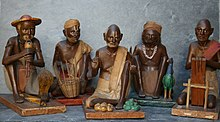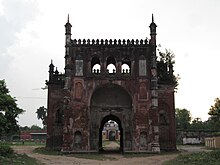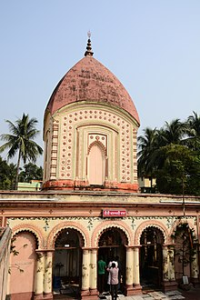রেউই গ্রাম থেকে কৃষ্ণনগরে রূপান্তরিত এই জনপদ মধ্যযুগে তার নাগরিক চরিত্র লাভ করে। বর্তমানে এটি নদিয়া জেলার সদর শহর। এখানে একাধিক ঐতিহাসিক স্মারক রয়েছে, যেগুলি আঞ্চলিক ইতিহাসের মূল্যবান সম্পদ। কৃষ্ণনগরের ঘূর্ণি যেমন মৃৎশিল্পের জন্য প্রসিদ্ধ। ঘূর্ণির মৃৎশিল্পের সুনাম সর্বজন বিদিত। আমাদের দেশের বিভিন্ন জায়গায়, এমনকি বিশ্বের বিভিন্ন দেশে ঘূর্ণির কারিগরদের তৈরি ভাস্কর্য দেখতে পাওয়া যায়। এবার কৃষ্ণনগর কলেজিয়েট স্কুলের প্রসঙ্গে আসা যাক। একদা এটি ছিল বিখ্যাত ব্যারিস্টার মনোমোহন ঘোষের নিবাস। মনমোহন ঘোষ (১৮৪৪-১৮৯৬ খ্রি.) ছিলেন কলকাতা হাইকোর্টের প্রথম ভারতীয় ব্যারিস্টার। কৃষ্ণনগর কলেজিয়েট স্কুল স্থাপিত হয় ১৮৪৬ সালে। একই সঙ্গে কৃষ্ণনগর কলেজও প্রতিষ্ঠিত হয়। প্রথমে তিনজন ইউরোপীয় শিক্ষক এবং দশজন ভারতীয় শিক্ষক নিয়ে এই প্রতিষ্ঠানের পঠনপাঠন শুরু হয়। বঙ্গের গৌরব ব্যারিস্টার মনোমোহন ঘোষ তাঁর বাড়িটি স্কুলকে দান করেন। পরবর্তীতে সেখানেই স্কুল স্থানান্তরিত হয়। এখানে শিক্ষকতা করেছেন রামতনু লাহিড়ী, মদনমোহন তর্কালঙ্কার, বেণীমাধব দাসের মতো ব্যক্তিরা। কৃষ্ণনগরের আরেকটি উল্লেখযোগ্য শিক্ষা প্রতিষ্ঠান হলো এ ভি হাইস্কুল। বিশিষ্ট শিক্ষক বাবু ব্রজনাথ মুখোপাধ্যায় ১৮৪৯ খ্রিস্টাব্দে কৃষ্ণনগরের নেদিয়ার পাড়ায় অ্যাংলো ভার্নাকুলার হাইস্কুল প্রতিষ্ঠা করেন। প্রথমে এই শিক্ষা প্রতিষ্ঠান লোকমুখে ‘ব্রজবাবুর পাঠশালা’ নামেই পরিচিতি পেয়েছিল। ব্রজনাথ মুখোপাধ্যায় ছিলেন কৃষ্ণনগরের অন্যতম পুরনো শিক্ষাপ্রতিষ্ঠান সি এম এস স্কুলের শিক্ষক। পরবর্তীতে তিনি নিজে উদ্যোগী হয়ে স্বতন্ত্র একটি শিক্ষা প্রতিষ্ঠান গড়ে তোলেন। ২০২৩ সালে কৃষ্ণনগর এ ভি হাইস্কুল ১৭৫তম বর্ষে পদার্পণ করেছে। এই শিক্ষা প্রতিষ্ঠান থেকে বহু কৃতি ছাত্র পাস করে বার হয়েছে। বিপ্লবী বাঘাযতীন কৃষ্ণনগরের অ্যাংলো ভার্নাকুলার হাইস্কুল থেকেই ১৮৯৮ সালে কৃতিত্বের সঙ্গে এন্ট্রান্স পাস করেন। বিখ্যাত নাট্যকার ও কবি দ্বিজেন্দ্রলাল রায় এই স্কুলের প্রাথমিক বিভাগে পড়তেন বলে জানা যায়। শহীদ অনন্তহরি মিত্র, স্বাধীনতা সংগ্রামী অমৃতেন্দু মুখার্জি প্রমুখরা এই বিদ্যালয়ের ছাত্র ছিলেন। কৃষ্ণনগরের অন্যতম ঐতিহাসিক নিদর্শন কৃষ্ণনগর ব্রাহ্মসমাজ। কিন্তু এই হেরিটেজ ভবনটি বর্তমানে জরাজীর্ণ। নদিয়া-রাজ শ্রীশচন্দ্র রায়ের পৃষ্ঠপোষকতায় কৃষ্ণনগর ব্রাহ্মসমাজ প্রথম স্থাপিত হয়েছিল। পশ্চিমবঙ্গ হেরিটেজ কমিশন ব্রাহ্মসমাজের বর্তমান ভবনটিকে হেরিটেজ সৌধ হিসেবে স্বীকৃতি দিয়েছে। মহর্ষি দেবেন্দ্রনাথ ঠাকুরের পৃষ্ঠপোষকতায় ১৭৬৯ শকাব্দে (অর্থাৎ ১৮৪৭ খ্রি.) এই ভবন নির্মিত হয়েছিল।
কৃষ্ণনগর রাজবাড়ির নহবৎখানা হলো একটি অন্যতম ঐতিহাসিক নিদর্শন। সম্প্রতি এই ঐতিহাসিক সৌধে সিমেন্ট বালির আস্তরণ চাপিয়ে সংস্কার করা হয়েছে। নদিয়া-রাজের রাজধানী মাটিয়ারী থেকে কৃষ্ণনগরে স্থানান্তরিত হওয়ার পর সেখানে রাজপ্রাসাদ, চক, নহবৎখানা প্রভৃতি নির্মাণ করা হয়। মহারাজা রুদ্র রায়ের আমলে মাটি, চুন সুরকির গাঁথনিতে ইটের তৈরি চারমিনার বিশিষ্ট তোরণরূপী এই নহবৎখানাটি নির্মিত হয়েছিল।
নদিয়া রাজবংশের সূচনা ধরা হয় ভবানন্দ মজুমদারের সময় থেকে। রামচন্দ্র সমাদ্দারের চার ছেলে ছিল। যাদের মধ্যে সবথেকে বড় ছিলেন ভবানন্দ। তিনি বাগোয়ান থেকে মাটিয়ারীতে রাজধানী স্থানান্তর করেছিলেন। পরবর্তীতে নদিয়া-রাজ রাঘব রায় সিংহাসনে বসে মাটিয়ারী থেকে রেউই গ্রামে রাজধানী স্থানান্তর করেন। রেউই গ্রামে ছিল গোপেদের বাস। সেই সময় মুঘল সাম্রাজ্যের অধিপতি ছিলেন সম্রাট শাহজাহান। মহারাজা রাঘব রায়ের পরে তাঁর পুত্র রুদ্র রায় সিংহাসনে বসেন। মহারাজা রুদ্র রায়ের রাজত্বকালে (১৬৭৬-১৬৯৩ খ্রি.) রেউই থেকে কৃষ্ণনগর নামকরণ হয়। রেউই গ্রামের অধিবাসী গোপেরা ঘটা করে শ্রীকৃষ্ণের পুজো করতেন। সে কারণেই মহারাজা রুদ্র রায় রেউই গ্রামের নাম রাখেন কৃষ্ণনগর। এভাবেই মধ্যযুগে কৃষ্ণনগর শহর জন্ম নেয়। সেই সময় মুঘল সম্রাট ছিলেন ঔরঙ্গজেব।
বিশিষ্ট স্থপতিকার আলাল দোস্তের সমাধি পীরতলা রাজবাড়ির সন্নিকটে অবস্থিত। মহরমের দিন এখানে মেলা বসে। বাবু রামতনু লাহিড়ীর বসতবাড়ির কিয়দংশ এখনো কৃষ্ণনগরে রয়েছে। ১৯৮১ সাল থেকে রামতনু লাহিড়ীর এই বাড়িতে ‘কৃষ্ণনগর একাডেমী’ নামে একটি ইংরেজি মিডিয়াম স্কুল স্থাপিত হয়েছে। কৃষ্ণনগর রেল স্টেশনের সন্নিকটে রয়েছে বাংলার প্রখ্যাত কবি সাহিত্যিক নাট্যকার দ্বিজেন্দ্রলাল রায়ের জন্মভিটে। দ্বিজেন্দ্রলাল রায়ের পিতা ছিলেন নদিয়া রাজবংশের দেওয়ান কার্ত্তিকেয়চন্দ্র রায়। তাঁদের পৈত্রিক ভিটের কিয়দংশ রয়েছে কৃষ্ণনগর রেলস্টেশন সংলগ্ন একখণ্ড জমিতে। রাস্তার (স্টেশন রোড) অপর দিকে দ্বিজেন্দ্র স্মৃতিধন্য দ্বিজেন্দ্র পাঠাগার রয়েছে। কাজী নজরুল ইসলামের স্মৃতিধন্য কৃষ্ণনগরের অন্যতম হেরিটেজ সৌধ হলো গ্রেস কটেজ। এই বাড়িটিতে নজরুল ইসলাম প্রায় আড়াই বছর (১৯২৬-১৯২৮ খ্রি.) সপরিবার বসবাস করেছিলেন। ‘দারিদ্র’ কবিতা, ‘মৃত্যুক্ষুধা’ উপন্যাসের রচনা এই বাড়িতেই। এখানেই সৃষ্টি হয় প্রথম বাংলা গজল গানের। কৃষ্ণনগরে রবীন্দ্রনাথ ঠাকুরের স্মৃতিধন্য একটি হেরিটেজ ভবন হলো রানিকুঠি। এটি ছিল সাহিত্যিক প্রমথ চৌধুরীদের পৈতৃক নিবাস। ১৮৮৬ খ্রিস্টাব্দের ২৫ এপ্রিল রবীন্দ্রনাথ ঠাকুর কৃষ্ণনগরে এসেছিলেন এবং এই বাড়িটিতে তিন চার দিন ছিলেন বলে জানা যায়। নদিয়া জেলার একটি অন্যতম প্রাচীন গির্জা হলো কৃষ্ণনগর ক্যাথিড্রাল। এটি গঠন ও নকশার দিক থেকে অন্যান্য গির্জার থেকে অনেকটাই আলাদা। গথিক, নিও-ক্লাসিক্যাল বা ভিক্টোরিয়ান নয়, একাধিক স্থাপত্য শৈলীর সংমিশ্রণে ১৮৯৯ সালে কৃষ্ণনগর ক্যাথিড্রালের বর্তমান ভবনটি নির্মিত হয়। কয়েক বছর আগে কৃষ্ণনগর ক্যাথিড্রালের প্রায় সম্মুখে নির্মিত হয়েছে আরেকটি বিশাল স্থাপত্য। যার নাম দেওয়া হয়েছে খ্রিস্টমন্দির। এর পাশ দিয়েই বয়ে গিয়েছে কৃষ্ণনগরের লুপ্তপ্রায় জলধারা অঞ্জনা। কৃষ্ণনগর কলেজ (বর্তমান নাম কৃষ্ণনগর গভর্নমেন্ট কলেজ) হলো নদিয়া জেলার প্রথম উচ্চশিক্ষা প্রতিষ্ঠান। আর সমগ্র বাংলার মধ্যে এটি হলো তৃতীয় প্রাচীন কলেজ। এটি হলো শহরের অন্যতম ঐতিহাসিক স্মারক। গভর্নর জেনারেল লর্ড হার্ডিঞ্জের সময়কালে (১৮৪৪- ১৮৪৮ খ্রি.) এই উচ্চশিক্ষা প্রতিষ্ঠান কৃষ্ণনগরে স্থাপিত হয়। বিখ্যাত শেক্সপিরিয়ার বিশেষজ্ঞ স্যর ডি এল রিচার্ডসন ছিলেন এই কলেজের প্রথম অধ্যক্ষ। তিনি ১৮৪৫ খ্রিস্টাব্দের ২৮ নভেম্বর অধ্যক্ষের দায়িত্বভার পেয়ে যান। যদিও কৃষ্ণনগর কলেজের প্রতিষ্ঠাকাল হলো ১৮৪৬ খ্রিস্টাব্দের ১ জানুয়ারি। জাতপাত নির্বিশেষে সকল সম্প্রদায়ের জন্য এই শিক্ষাপ্রতিষ্ঠানটি উন্মুক্ত ছিল। কৃষ্ণনগর কলেজিয়েট স্কুল ও কৃষ্ণনগর কলেজ একসঙ্গেই পথচলা শুরু করেছিল। এই প্রতিষ্ঠানের প্রথম যৌথ শিক্ষকমণ্ডলীর মধ্যে অধ্যক্ষ ডি এল রিচার্ডসন ছাড়াও আরো তিনজন ইউরোপীয় শিক্ষক ছিলেন— ব্রাডবুরি, বিটসন ও বিনল্যান্ড। এছাড়াও ছিলেন দশজন ভারতীয় শিক্ষক।
Krishnanagar is an important centre for culture and literature. It counts literary figures such as Ray Gunakor Bharatchandra, Ramprasad Sen, Dwijendralal Ray and Narayan Sanyal among many others. There is also a strong tradition of stage acting and Indian revolutionary movements. Several elegant pieces of handicraft arts can also be found in this region, namely the handicraft in making of carpet, bamboo and jute crafts, miniature paintings. a horticultural research station and jute nursery, and an agricultural training centre.
Jagaddhatri Puja is celebrated with grandeur in Krishnanagar, when lighting from the town of Chandannagar are brought. The origins of Jagaddhatri Puja in Krishnanagar can be traced back to the 18th century, when it was first celebrated by Maharaja Krishna Chandra, the king of Krishnanagar. Initiated by Krishna Chandra in 1762, is the crowning glory of the annual festival. The Maharaja’s absence from the Durga Puja that year left him heartbroken as he could not offer his prayers to Maa Durga. Returning by boat on Dasami, the day of idol immersion, the Maharaja saw the idols being immersed in the river and was overcome with grief. However, in a dream that night, he saw a teenage Goddess seated on a lion, resembling a white horse, assuring him that she would come to him on the Sukla Nabami tithi in the Bengali month of Kartick (October–November). Following her divine instructions, an idol of Goddess Jagaddhatri was sculpted and the puja was performed with great pomp and splendor. Jagaddhatri Puja is celebrated across the Paras of Krishnanagar , with each Paras having its own unique customs and traditions. The Paras are essentially different neighborhoods or communities within the town, each with its own distinct identity and character. The most prominent of them all is Chasapara Barowari Puja where the deity is called Burima. This festival that has been celebrated for over 100 years, is known for its grandeur and splendor. The festival is organized by the Chasapara Barowari Committee, and it is celebrated with great enthusiasm and devotion by the locals. The festival is known for its magnificent pandal decorations, which are designed based on various themes and concepts. The pandals are adorned with colorful lights, flowers, and other decorative items, making them a visual treat for the visitors. During the Puja, the locals also perform a unique ritual called “chokkhudaan” where they offer their eyes to the Goddess in the form of a symbolic gesture. This ritual is believed to signify the devotee’s willingness to see the truth and the divine light. The festival is also known for its colorful processions, which are accompanied by the beats of the dhak, a traditional
percussion instrument. One of the notable features of this Chasapara Barowari is the heavily adornment of Burima with gold jewellery. It is believed that Burima fulfills her true devotees wishes.
Krishnanagar is also famous for its Barodol Mela. Maharaja Krishnachandra, a devoted husband, once failed to fulfill his promise of taking his beloved queen to the neighboring fair at Ula Birnagar. To make up for it, he organized a grand festival in his own palace where 12 idols of Krishna were invited for a month-long stay. The tradition continues to this day, with the royal household playing a vital role in the festival’s success, even though its splendor has faded somewhat over time.The festival is normally held after the Dolyatra in the Sukla Ekadashi tithi. It begins with the arrival of 12 idols of Krishna , each representing a different form of the deity. The idols are displayed for public viewing for the first three days of the festival, after which they retire to a temple inside the palace as guests of the patron deity Boro Narayan. Meanwhile, the month-long fair takes place in the vast field next to the old fort’s gate, open to all who wish to participate. The fairgrounds are alive with the sounds of vendors hawking their wares, performers entertaining the crowds, and children laughing and screaming in delight as they ride the rides. The fair also provides a platform for local artisans to showcase their skills and sell their wares. From the clay toy makers to the handloom weavers, the fair is an opportunity for these artisans to display their products to a wider audience and earn a living.
 The famous area called Ghurni is the birthplace of Yogiraj Sri Shyama Charan Lahiri Mahasaya, fountain-head of Kriya Yoga. Ghurni is the neighbourhood of the clay artists. Open studios and shops of the artists comprise an important attraction for tourists. It is said that initially it was Raja Krishnachandra who had settled a few families of talented clay artists in the area
The famous area called Ghurni is the birthplace of Yogiraj Sri Shyama Charan Lahiri Mahasaya, fountain-head of Kriya Yoga. Ghurni is the neighbourhood of the clay artists. Open studios and shops of the artists comprise an important attraction for tourists. It is said that initially it was Raja Krishnachandra who had settled a few families of talented clay artists in the area
 Rajbari, also known as the Krishnanagar Palace, is a royal palace with a Durga temple in the courtyard. The Durga puja was started by Raja Rudra Roy, the great-grandfather of Raja Krishnachandra Roy. Every year, Jhulan Mela is celebrated around the Rajbari in July–August and Baro Dol (as it is held 12 days after Dol Purnima) in March–April every year. Rajbari is mostly visited for the celebration of different festivals. These include the popular Jhulan Mela and the festival of colours Holi or Baro Dol. The historical monument surrounded by a water-body known as Dighi has a beautiful Goddess Durga temple erected in its central courtyard.
Rajbari, also known as the Krishnanagar Palace, is a royal palace with a Durga temple in the courtyard. The Durga puja was started by Raja Rudra Roy, the great-grandfather of Raja Krishnachandra Roy. Every year, Jhulan Mela is celebrated around the Rajbari in July–August and Baro Dol (as it is held 12 days after Dol Purnima) in March–April every year. Rajbari is mostly visited for the celebration of different festivals. These include the popular Jhulan Mela and the festival of colours Holi or Baro Dol. The historical monument surrounded by a water-body known as Dighi has a beautiful Goddess Durga temple erected in its central courtyard.

As per the historical information so far available, the ancestor of Maharaja Krishnachandra of Nadia district, started living in a village named ‘Reui’ after migrating from their the then residence at Matiara, Banpur situated at south-east of present Krishnagar. Maharaja Raghab, the grandson of Bhabananda Majumder (the first person of the Royal family), constructed a ‘Palace’ at Reui for their living. Afterwards, Maharaja Rudra Roy, the son of Maharaja Raghab named the place as ‘Krishnanagar’ as a mark of respect and reverence to Lord Krishna, while some persons believe that it was so named after the great annual Krishna-festival of the milkmen-community, the original residents of Reui.
However, in the mid-18th Century during the reign of Maharaja Krishnachandra, one of their successors in the 3rd or 4th generation and a contemporary of the then Nawab of Bengal Siraj-Ud-Doulya, the major developments in the field of Art, Culture & Literature took place. His royal court used to be graced by a galaxy of learned courtiers, some of them being well versed in Sanskrit literature. The great poet Bharat Chandra was his court-poet and during his tenure in the court Bharat Chandra composed the noted book of verse named ‘Annada Mangal’. In appreciation of his talent Maharaja awarded him the title of ‘Gunakar’. Another courtier was Sankar Taranga, who was brave, witty and an eloquent Speaker. However, the common belief of the existence of ‘Gopal Bhanr’ as the court-jester is not seconded by the historians. Such character might be an imaginary one, may be in resemblance of Sankar Taranga.
During these days, the literary and cultural environment started shining, which had, in fact, formed subsequently a cultural heritage. In fact, the tradition has flown during the 19th & 20th Century, as well. Dwijendra Lal Roy, a noted poet, dramatist and lyricist was born in this town in the year 1863 and this great son of the soil resorted to his strong pen in awakening patriotism in the country for freedom-struggle against the British rulers. Besides, the town is also the birth-place Ramtanu Lahiri, a noted educationist, who had in fact dedicated his life for reform and spread of education. This town has also been gratified with the glorious & memorable presence of great personalities like Pt. Iswar Chandra Vidyasagar, Rabindra Nath Thakur, Deshabandhu Chittaranjan Das, Sarojini Naidu, Kazi Nazrul Islam and also Subhas Chandra Bose.
At the humble invitation of Ramtanu Lahiri, Vidyasagar once graced the residence of Ramtanu Lahiri at Beledanga, Krishnagar with his kind presence. Rabindra Nath Thakur spent a few days at ‘Rani Kuthi’, Krishnagar. Deshabandhu Chittaranjan Das paid his kind visit in this town in connection with the electoral campaign in favour of Hemanta Kr. Sarkar, when he also visited the library founded by Ananta Hari Mitra, a freedom-fighter who was later put to death as a Martyr on 28th Sept., 1926. At the humble request of A. H. Mitra, Desabandhu named the library as ‘Sadhana Library’. Later, the Library was visited by Subhas Chandra Bose also, when he used to come to the residence of Hemanta kr. Sarkar, during 1923-’24. Sarojini Naidu paid her kind visit in this town, when she graced the Chair of the Chief Guest at the provincial conference of Indian National Congress held at Rajbari, Krishnagar in 1926 under the presidentship of Nirmal Chanda. Kazi Nazrul Islam stayed in this town for some days at the house named ‘Grace Cottage’, when he composed his famous poem ‘Kandari Hunsiar’.
Besides, the town is also proud of being the birth place of a galaxy of distinguished personalities like Ramtanu Lahiri, a noted educationist, who had in fact dedicated his life for reform and spread of education; Suresh Chandra Sarkar, the founder-editor of ‘Ananda Bazar Patrika’ and also ‘Hindusthan Standard’ and the weekly magazine ‘Desh’; Jagadananda Roy, a noted writer on Science-based subjects; Hemanta Kr. Sarkar, a great freedom-fighter & one of the closest disciples of Deshabandhu; Lalmohan Ghosh, a noted Barrister & one of the very senior organizers of Indian National Congress; Maharaja Khounish Chandra Roy, a great patroniser of Art, Culture & Education.
Moreover, the residents of this town had also been blessed to have witnessed closely the memorable activities of eminent persons like Pramatha Chowdhury, Kumud Nath Chowdhury, Jatindra Nath Mukhopadhyay (Bagha Jatin), Martyr Ananta Hari Mitra,Pandit Lakhsmikanta Moitra; Freedom-fighter Tarakdas Bandyopadhyay; Manmohan Ghosh, a great freedom-fighter, an eminent Barrister by profession, the first Press-Reporter of Nadia District, who had published the Fortnightly Journal ‘Indian Mirror’ in 1861 and at whose residence Michael Madhusudan had spent a few days; Brajanath Mukhopadhyay, an educationist & a dedicated Social Worker and founder of Krishnagar A.V. School: Azizul Haque and such others, who all had their respective sphere of activities in this town.
Another landmark in the field of Art & Craft, which was fostered under the direct patronage of the Art-lover Maharaja, is ‘clay models’. The artisans of this handicraft settled in the areas namely Sasthitala, Natunbazar Rathtala and Ghurni. The clay-models of ‘human-figures’ of Ghurni has earned a nation-wide fame for its highly skilled craftsmanship, while the sculptural work of Ghurni is renowned both in the country and the abroad. Ghurni is also the birthplace of Yogiraj Shri Shyama Charan Lahiri Mahasaya who was born on 30th September 1828 at Ghurni. He was an Indian Yogi and a disciple of Mahavatar Babaji. He revived the Yogic Science of Kriya Yoga.
